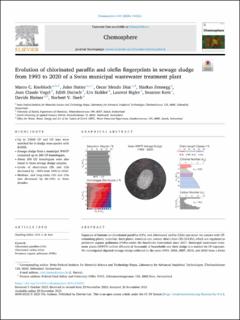Please use this identifier to cite or link to this item:
https://doi.org/10.21256/zhaw-29417| Publication type: | Article in scientific journal |
| Type of review: | Peer review (publication) |
| Title: | Evolution of chlorinated paraffin and olefin fingerprints in sewage sludge from 1993 to 2020 of a Swiss municipal wastewater treatment plant |
| Authors: | Knobloch, Marco C. Hutter, Jules Mendo Diaz, Oscar Zennegg, Markus Vogel, Jean Claude Durisch, Edith Stalder, Urs Bigler, Laurent Kern, Susanne Bleiner, Davide Heeb, Norbert V. |
| et. al: | No |
| DOI: | 10.1016/j.chemosphere.2023.140825 10.21256/zhaw-29417 |
| Published in: | Chemosphere |
| Volume(Issue): | 349 |
| Issue: | 140825 |
| Issue Date: | 29-Nov-2023 |
| Publisher / Ed. Institution: | Elsevier |
| ISSN: | 0045-6535 1879-1298 |
| Language: | English |
| Subjects: | Chlorinated olefins (COs); Chlorinated paraffins (CPs); Fingerprinting; Orbitrap mass spectrometry; Persistent organic pollutants (POPs); RASER (R-based automated spectra evaluation routine) |
| Subject (DDC): | 540: Chemistry |
| Abstract: | Exposure of humans to chlorinated paraffins (CPs) and chlorinated olefins (COs) can occur via contact with CP-containing plastic materials. Such plastic materials can contain short-chain CPs (SCCPs), which are regulated as persistent organic pollutants (POPs) under the Stockholm Convention since 2017. Municipal wastewater treatment plants (WWTP) collect effluents of thousands of households and their sludge is a marker for CP exposure. We investigated digested sewage sludge collected in the years 1993, 2002, 2007, 2012, and 2020 from a Swiss WWTP serving between 20000 and 23000 inhabitants. A liquid chromatography mass spectrometry (R > 100000) method, in combination with an atmospheric pressure chemical ionization source (LC-APCI-MS), was used to detect mass spectra of CPs and olefinic side products. A R-based automated spectra evaluation routine (RASER) was applied to search for ∼23000 ions whereof ∼6000 ions could be assigned to CPs, chlorinated mono- (COs), di- (CdiOs) and tri-olefins (CtriOs). Up to 230 CP-, 120 CO-, 50 CdiO- and 20 CtriO-homologues could be identified in sludge. Characteristic fingerprints were deduced describing C- and Cl-homologue distributions, chlorine- (nCl) and carbon- (nC) numbers of CPs and COs. In addition, proportions of saturated and unsaturated material were determined together with proportions of different chain length classes including short- (SC), medium- (MC), long- (LC) and very long-chain (vLC) material. A substantial reduction of SCCPs of 84% was observed from 1993 to 2020. Respective levels of MCCPs, LCCPs and vLCCPs decreased by 61, 69 and 58%. These trends confirm that banned SCCPs and non-regulated CPs are present in WWTP sludge and higher-chlorinated SCCPs were replaced by lower chlorinated MCCPs. Combining high-resolution mass spectrometry with a selective and fast data evaluation method can produce characteristic fingerprints of sewage sludge describing the long-term trends in a WWTP catchment area. |
| URI: | https://digitalcollection.zhaw.ch/handle/11475/29417 |
| Fulltext version: | Published version |
| License (according to publishing contract): | CC BY 4.0: Attribution 4.0 International |
| Departement: | Life Sciences and Facility Management |
| Organisational Unit: | Institute of Chemistry and Biotechnology (ICBT) |
| Appears in collections: | Publikationen Life Sciences und Facility Management |
Files in This Item:
| File | Description | Size | Format | |
|---|---|---|---|---|
| 2024_Knobloch-etal_Evolution-chlorinated-paraffin-olefin-fingerprints.pdf | 5.65 MB | Adobe PDF |  View/Open |
Show full item record
Knobloch, M. C., Hutter, J., Mendo Diaz, O., Zennegg, M., Vogel, J. C., Durisch, E., Stalder, U., Bigler, L., Kern, S., Bleiner, D., & Heeb, N. V. (2023). Evolution of chlorinated paraffin and olefin fingerprints in sewage sludge from 1993 to 2020 of a Swiss municipal wastewater treatment plant. Chemosphere, 349(140825). https://doi.org/10.1016/j.chemosphere.2023.140825
Knobloch, M.C. et al. (2023) ‘Evolution of chlorinated paraffin and olefin fingerprints in sewage sludge from 1993 to 2020 of a Swiss municipal wastewater treatment plant’, Chemosphere, 349(140825). Available at: https://doi.org/10.1016/j.chemosphere.2023.140825.
M. C. Knobloch et al., “Evolution of chlorinated paraffin and olefin fingerprints in sewage sludge from 1993 to 2020 of a Swiss municipal wastewater treatment plant,” Chemosphere, vol. 349, no. 140825, Nov. 2023, doi: 10.1016/j.chemosphere.2023.140825.
KNOBLOCH, Marco C., Jules HUTTER, Oscar MENDO DIAZ, Markus ZENNEGG, Jean Claude VOGEL, Edith DURISCH, Urs STALDER, Laurent BIGLER, Susanne KERN, Davide BLEINER und Norbert V. HEEB, 2023. Evolution of chlorinated paraffin and olefin fingerprints in sewage sludge from 1993 to 2020 of a Swiss municipal wastewater treatment plant. Chemosphere. 29 November 2023. Bd. 349, Nr. 140825. DOI 10.1016/j.chemosphere.2023.140825
Knobloch, Marco C., Jules Hutter, Oscar Mendo Diaz, Markus Zennegg, Jean Claude Vogel, Edith Durisch, Urs Stalder, et al. 2023. “Evolution of Chlorinated Paraffin and Olefin Fingerprints in Sewage Sludge from 1993 to 2020 of a Swiss Municipal Wastewater Treatment Plant.” Chemosphere 349 (140825). https://doi.org/10.1016/j.chemosphere.2023.140825.
Knobloch, Marco C., et al. “Evolution of Chlorinated Paraffin and Olefin Fingerprints in Sewage Sludge from 1993 to 2020 of a Swiss Municipal Wastewater Treatment Plant.” Chemosphere, vol. 349, no. 140825, Nov. 2023, https://doi.org/10.1016/j.chemosphere.2023.140825.
Items in DSpace are protected by copyright, with all rights reserved, unless otherwise indicated.